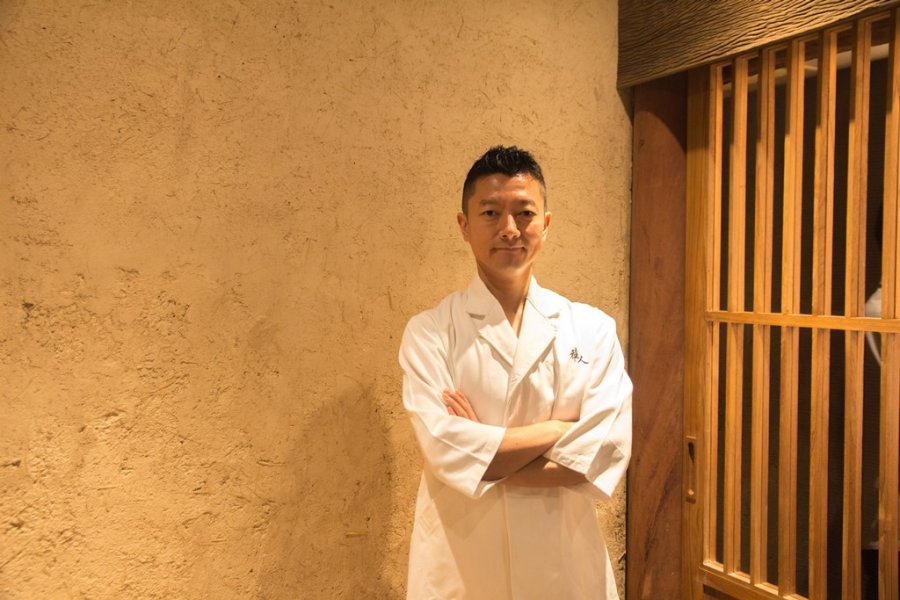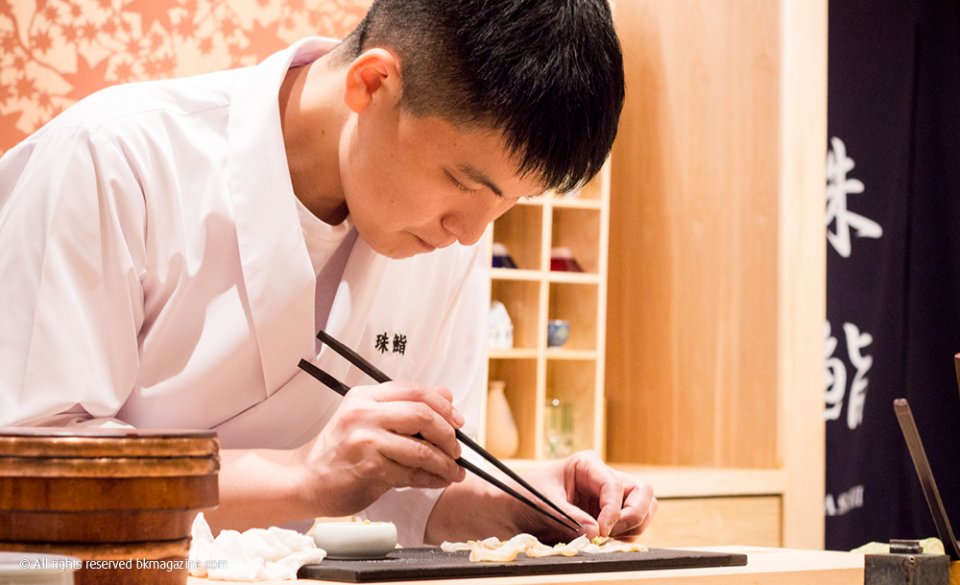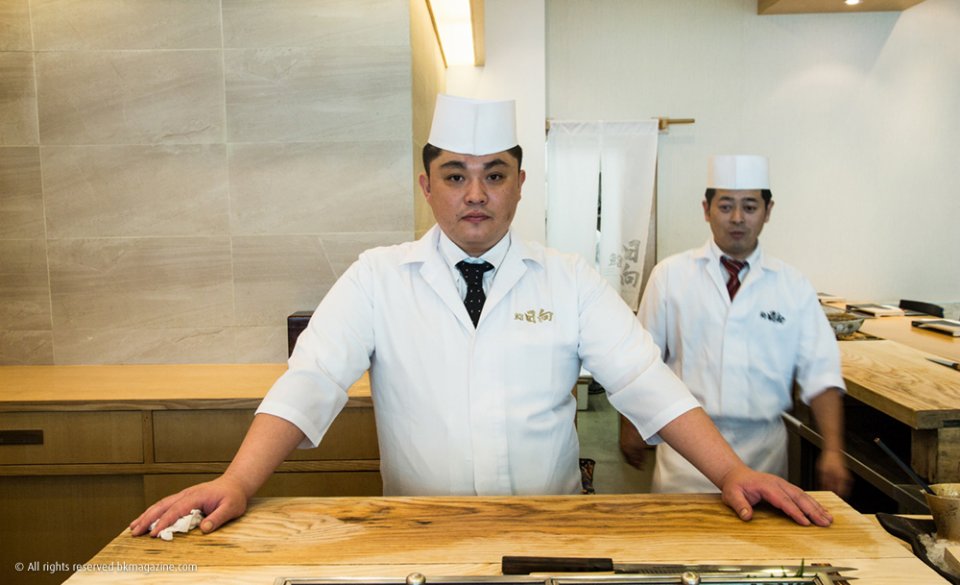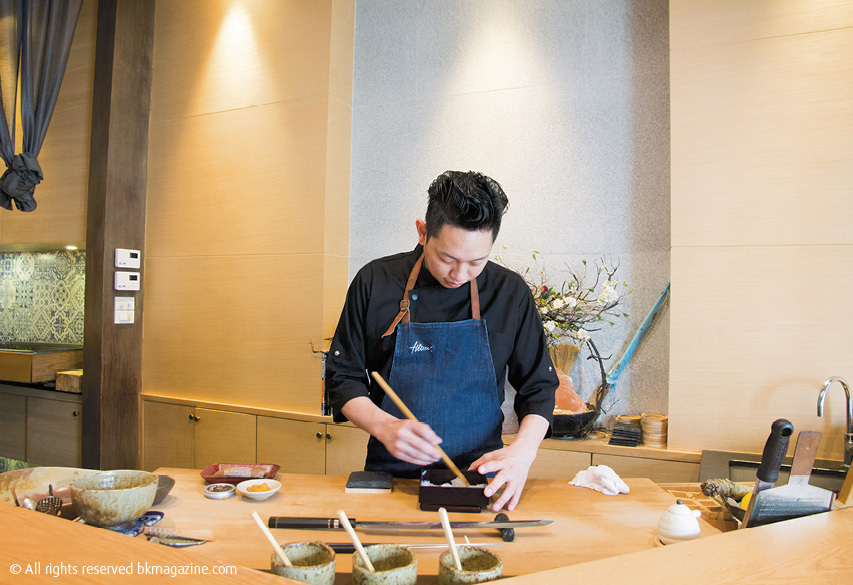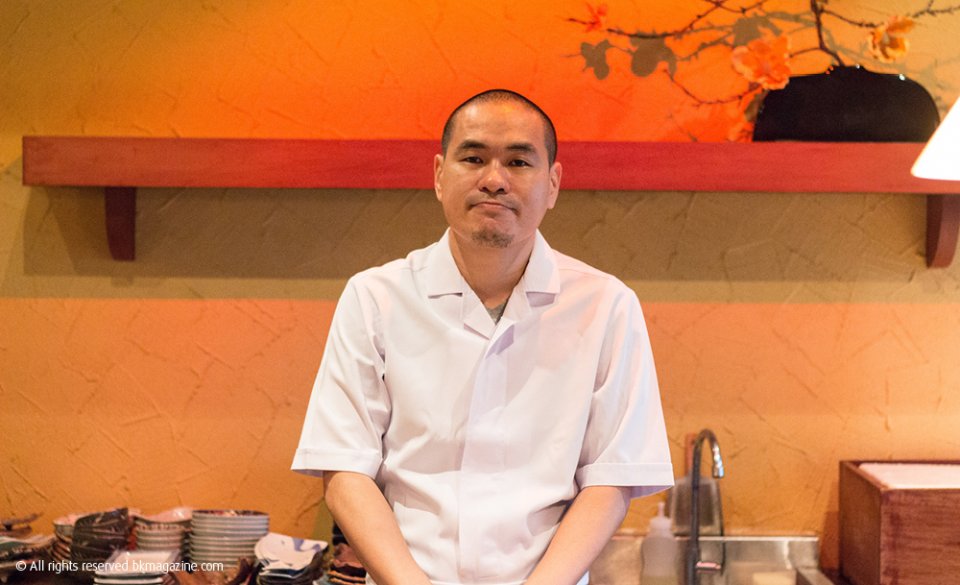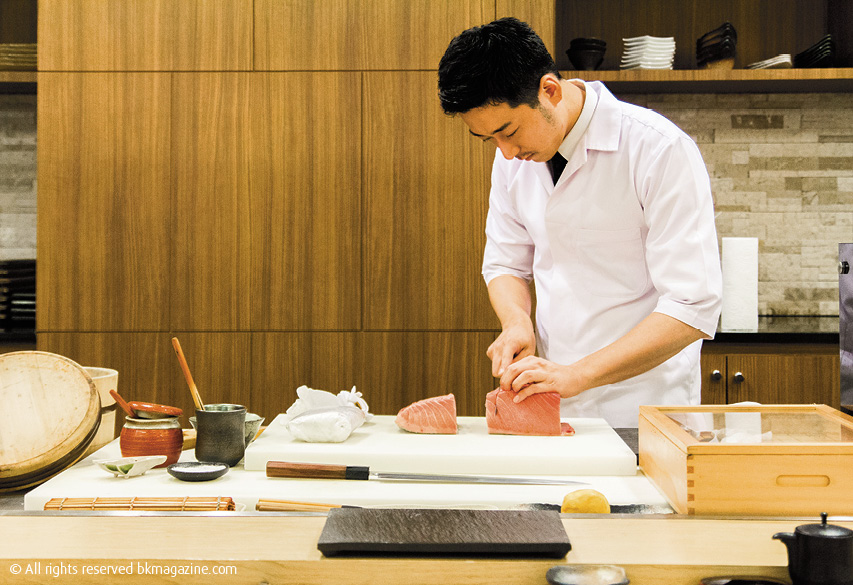Literally meaning “I’ll leave it up to you” in Japanese, omakase sees diners entrust their dinner to the chef.
Sushi Masato
The Scene
The last 24 months have seen an explosion in the number of restaurants offering omakase, from imported big names like
Sushi Masato, helmed by Japan-native Masato Shimizu, who became the youngest chef in NYC ever to win a Michelin star at just 29, to a host of local chefs. Thais making their name in omakase include Wacharun Iamarramsak, chef-owner of
In the Mood for Love; his previous team member Charoensri Somsook, chef of
Mizu by Sankyodai; Banphot Boonklom, chef of
Umi (previously of Sushi Cyu); and Chaichat “Randy” Noprapa, chef of
Fillets, who had a stint in the kitchen of Masaharu Morimoto, one of America’s most-praised Japanese chefs.
Mizu
The Show
Omakase is basically a chef’s time to shine. The man behind the counter acts as both director and performer in a culinary performance that can last two hours. It takes Japanese chefs years of learning all about hot and cold kitchens before they actually get their hands on something as delicate as sushi. “Sushi is the last step in a Japanese chef’s career,” says Charoensri, of Mizu by Sakyodai. The experience is incredibly intimate. As Wacharun, of In the Mood for Love, says, “There’s no other form of dining in the world that brings diners so close to the chef. Throughout each course, they get to know more and more about the chef.”
Ginza Sushi Ichi
Tama
The Courses
An omakase set usually contains a few appetizers, a range of sushi as the main and then tamago, soup and dessert. “I like to serve seasonal fresh sashimi as appetizers,” says
Ginza Sushi Ichi’s executive chef Masakazu Ishibashi, who trains all the chefs in the Sushi Ichi empire. At Fillets, chef Randy not only lets the fresh fish shine in the form of sashimi, but also plays around with the likes of fresh
shiro ebi (glass shrimp) served with osetra caviar and dried fluke roe. On the other hand,
Tama chef Seiji Sudo (previously head chef at Bangkok’s branch of Ginza Sushi Ichi) doesn’t stick to nigiri for the main course, offering sashimi and other funky items like grilled mixed rice with hairy crab meat and uni.
Umi
The Sushi
Edomae, the most popular style of sushi, requires special handling. “At the time this style of sushi originated, more than 300 years ago, there were no refrigerators. So in order to keep fish and rice from spoiling, sushi stall chefs had to preserve them by curing, marinating, seasoning or cooking,” says Shimizu, chef-owner of Sushi Masato. Techniques include curing and marinating fish in salt, vinegar, soy sauce, sake and seaweed. Sushi rice is also an important element. Most places use red vinegar to season their rice, while Ginza Sushi Ichi and Umi use both red and white vinegar to season two different kinds of rice.
Sushi Hinata
The Sequence
“It’s the chef’s task to create harmony throughout the whole meal,” says Sato Tomohiko, chef of
Sushi Hinata. While there’s a rule of thumb that milder-tasting fish like white fish should be served earlier and stronger red-flesh fish later, some chefs decide to chart their own taste journey. “I want my diners to feel excited throughout the course,” says chef Randy of breaking with the rules.
Sakuragawa Sushi’s chef-owner Takuya Komada too likes to switch between oily and less oily fish. “If every heavy piece is served toward the end of the course, you can easily feel like you have eaten too much. As a customer, I wouldn’t like it.” Some chefs also like to break the nigiri journey into two or three parts, interspersed with sashimi or cooked items.
Fillets
In the Mood for Love
The Rest
After the main course, you’re likely to be served tamago, a type of Japanese omelet where a chef will often try to add his own flourishes. In Bangkok we can see the diversity on show, from the spongy and airy tamago at Fillets to the smooth and custardy one at Mizu, with various levels of sweetness and saltiness at play. Wacharun says: “My tamago is dense and almost unsweet. My set also doesn’t include desserts as I’m personally not a dessert person. I only cook what I find tasty.” Elsewhere, the most popular desserts include ice cream and puddings.
The Diners
When we asked chefs how diners can get the most out of their omakase experience, the answer was unanimous: eat whatever you’re served as soon as possible. Using your hands to eat sushi is the preferred option. Pressing too hard with chopsticks can cause the sushi rice to crumble. Some chefs, like Komada of Sakuragawa Sushi, prepare for this: “If I spot diners who prefer using chopsticks, I’ll make their sushi a bit denser so that the rice ball stays in one piece.” Also note that every piece of sushi you get from a chef is already seasoned. There’s no need to put that extra wasabi or soy sauce on it. While a chef will attempt to cater to diners’ limitations, in return they expect open-mindedness to successfully showcase their best.

Tip: Fish Down?
They say good sushi will break and blend in your mouth, resulting in a flavor that’s more than the sum of its parts. Most chefs recommend eating sushi fish-side down: you’ll get the varying flavors and temperatures of the fish first, instead of the rice, which may stay the same throughout the meal.
Essentials
Fillets. B6,000 for about 15 items. Only Sun-Fri at 7:30pm. Maximum 8 people. 3/F, Portico, 31 Lang Suan Rd., 02-041-6056. BTS Chit Lom.
Ginza Sushi Ichi. Lunch from B1,300-4,000 for about 10-15 items. Tue-Sun noon-2pm; Dinner from B4,000-7,000 with 8 nigiri and 7-10 other items. Tue-Sun 6-9:30pm. LG/F, Erawan Bangkok, 494 Ploen Chit Rd., 02-250-0014. BTS Chit Lom
In the Mood for Love. B4,500-6,500 for 9-14 sushi, appetizers, soup and tamago. Tue-Sun 5:30-midnight. Maximum 6 people. 69 Ekkamai Soi 1, Bangkok, 02-392-8477
Mizu by Sankyodai. Lunch from B1,500-3,300 for 9-15 items. Tue-Sun 11:30am-2:30pm; Dinner from B2,500-6,500 for 10-18 items. Tue-Sun 5:30-10:30pm. 2/F, Charn Issara Tower, 942/43 Rama 4 Rd., 02-632-6660. MRT Silom
Sakuragawa. B3,000-5,500 for 14-20 items. Tue-Sun 11:30pm-3pm; 5:30-10pm. Maximum 8 people.B1/F, Jasmine Tower, Sukhumvit Soi 23, 098-829-5278. BTS Asok
Sushi Hinata. B5,000 for about 20 items. Maximum 12 people. 5/F, Central Embassy, 1031 Phloen Chit Rd., 02-160-5935. BTS Phloen Chit
Sushi Masato. B4,000 for about 20 items. Tue-Sun 5:30pm and 9pm. Maximum 9 people. 3/22 Sawasdee Soi 1, Sukhumvit Soi 31, 02-040-0015. BTS Phrom Phong
Tama. B6,500 for about 23 items. Tue-Sun 6pm and 8:30pm. Maximum 6 people. M/F (above Karatama Robatayaki), Piman 49, Sukhumvit Soi 49, 091-871-0666
Umi. B5,000 for about 20 items. Tue-Sun noon-2pm; 6-11pm. Maximum 10 people. 2/F (above Kai Yang Sua Yai by Mangmoom), Piman 49, Sukhumvit 49, 02-662-6661

